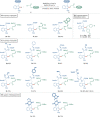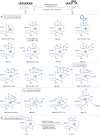Late-stage stitching enabled by manganese-catalyzed C─H activation: Peptide ligation and access to cyclopeptides
- PMID: 33637533
- PMCID: PMC7909873
- DOI: 10.1126/sciadv.abe6202
Late-stage stitching enabled by manganese-catalyzed C─H activation: Peptide ligation and access to cyclopeptides
Abstract
Bioorthogonal late-stage diversification of structurally complex peptides bears enormous potential for drug discovery and molecular imaging. Despite major accomplishments, these strategies heavily rely on noble-metal catalysis. Herein, we report on a manganese(I)-catalyzed peptide C─H hydroarylation that enabled the stitching of peptidic and sugar fragments, under exceedingly mild and racemization-free conditions. This convergent approach represents an atom-economical alternative to traditional iterative peptide synthesis. The robustness of the manganese(I) catalysis regime is reflected by the full tolerance of a plethora of sensitive functional groups. Our strategy enabled an expedient access to challenging cyclic peptides by a modular late-stage macrocyclization of structurally complex peptides.
Copyright © 2021 The Authors, some rights reserved; exclusive licensee American Association for the Advancement of Science. No claim to original U.S. Government Works. Distributed under a Creative Commons Attribution NonCommercial License 4.0 (CC BY-NC).
Figures






Similar articles
-
Late-stage C-H Functionalization of Tryptophan-Containing Peptides with Thianthrenium Salts: Conjugation and Ligation.Angew Chem Int Ed Engl. 2023 Feb 20;62(9):e202216661. doi: 10.1002/anie.202216661. Epub 2023 Jan 24. Angew Chem Int Ed Engl. 2023. PMID: 36581584
-
Chemodivergent manganese-catalyzed C-H activation: modular synthesis of fluorogenic probes.Nat Commun. 2021 Jun 7;12(1):3389. doi: 10.1038/s41467-021-23462-9. Nat Commun. 2021. PMID: 34099672 Free PMC article.
-
Late-Stage Peptide Diversification through Cobalt-Catalyzed C-H Activation: Sequential Multicatalysis for Stapled Peptides.Angew Chem Int Ed Engl. 2019 Feb 4;58(6):1684-1688. doi: 10.1002/anie.201811668. Epub 2019 Jan 9. Angew Chem Int Ed Engl. 2019. PMID: 30499607
-
Late-Stage Peptide Diversification by Position-Selective C-H Activation.Angew Chem Int Ed Engl. 2018 Nov 5;57(45):14700-14717. doi: 10.1002/anie.201806250. Epub 2018 Oct 9. Angew Chem Int Ed Engl. 2018. PMID: 29969532 Review.
-
Peptide macrocyclization by transition metal catalysis.Chem Soc Rev. 2020 Apr 7;49(7):2039-2059. doi: 10.1039/c9cs00366e. Chem Soc Rev. 2020. PMID: 32142086 Review.
Cited by
-
Selective Labeling of Peptides with o-Carboranes via Manganese(I)-Catalyzed C-H Activation.Chemistry. 2022 Jul 1;28(37):e202200811. doi: 10.1002/chem.202200811. Epub 2022 May 23. Chemistry. 2022. PMID: 35420234 Free PMC article.
-
Reusable Manganese Catalyst for Site-Selective Pyridine C-H Arylations and Alkylations.Chemistry. 2021 Sep 6;27(50):12737-12741. doi: 10.1002/chem.202101894. Epub 2021 Jul 29. Chemistry. 2021. PMID: 34181789 Free PMC article.
-
Transition-Metal-Catalyzed C-H Bond Activation for the Formation of C-C Bonds in Complex Molecules.Chem Rev. 2023 Jun 28;123(12):7692-7760. doi: 10.1021/acs.chemrev.2c00888. Epub 2023 May 10. Chem Rev. 2023. PMID: 37163671 Free PMC article. Review.
-
Macrocyclization strategies for cyclic peptides and peptidomimetics.RSC Med Chem. 2021 Jun 29;12(8):1325-1351. doi: 10.1039/d1md00083g. eCollection 2021 Aug 18. RSC Med Chem. 2021. PMID: 34447937 Free PMC article. Review.
-
Beyond 20 in the 21st Century: Prospects and Challenges of Non-canonical Amino Acids in Peptide Drug Discovery.ACS Med Chem Lett. 2023 Apr 24;14(5):557-565. doi: 10.1021/acsmedchemlett.3c00037. eCollection 2023 May 11. ACS Med Chem Lett. 2023. PMID: 37197469 Free PMC article. Review.
References
-
- Blakemore D. C., Castro L., Churcher I., Rees D. C., Thomas A. W., Wilson D. M., Wood A., Organic synthesis provides opportunities to transform drug discovery. Nat. Chem. 10, 383–394 (2018). - PubMed
-
- Räder A. F. B., Weinmüller M., Reichart F., Schumacher-Klinger A., Merzbach S., Gilon C., Hoffman A., Kessler H., Orally active peptides: Is there a magic bullet? Angew. Chem. Int. Ed. 57, 14414–14438 (2018). - PubMed
-
- Smolyar I. V., Yudin A. K., Nenajdenko V. G., Heteroaryl rings in peptide macrocycles. Chem. Rev. 119, 10032–10240 (2019). - PubMed
-
- Itoh H., Inoue M., Comprehensive structure–activity relationship studies of macrocyclic natural products enabled by their total syntheses. Chem. Rev. 119, 10002–10031 (2019). - PubMed
Publication types
LinkOut - more resources
Full Text Sources
Other Literature Sources

